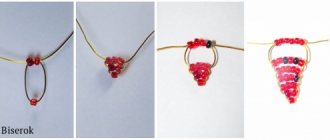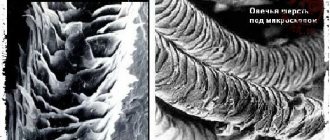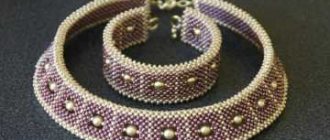09 February 2016
Photography is what painting, composition, plastic rhythm, geometry become, placed in a matter of seconds (Henri Cartier-Bresson).
Photo: Ronald Koster
When we think about composition in photography , the first thing that comes to mind is the golden ratio, the rule of thirds, aspect ratio, contrast, shooting point...
But there is another important element in composition - geometry . Geometry in photography refers to simple shapes such as square, triangle, circle, straight and curved lines.
Geometric objects are usually auxiliary; they enhance perception and can combine individual elements of a photograph into a single whole. By choosing one or another geometric shape in a photograph, the author can in advance focus the attention of the future viewer on certain areas of it. It has been established, for example, that the corners of a square turn out to be very active zones, and for a circle or oval it is the center. It is no coincidence that since ancient times there has been a tradition of portraits in an oval. The angles did not distract attention from the main thing - the image of the face. The most common and most versatile geometric tool is lines . Read more about them in our separate article.
In fact, any environmental object can be compared to any geometric figure, but they all awaken different emotions and feelings in the viewer. Simple geometric shapes, such as a circle and a square, are recorded much faster by our eyes and perceived by the brain, and therefore are remembered better than complex and irregular ones. In general, there are three basic figures. These are rectangle, triangle and circle . Everything else - oval, square, trapezoid, ellipse, rhombus - are just their variations. They are all different both graphically and (don't be surprised) emotionally.
SQUARE IN COMPOSITION
The square is the most stable, complete form, ready to evoke affirming images. It is associated with concepts such as order, stability, reliability, strength. At the same time, the square is perceived as somewhat mundane and ponderous.
Photo: Robertino Nikolic. “Light plays with geometry or geometry with light?” Winner of the Black & White Spider Awards, 2007.
Photo: Alma (source - 1510.deviantart.com)
Photo: G. Diaz Deleon
RECTANGLE IN COMPOSITION
A rectangle located with its larger side horizontally evokes a feeling of stability, peace, and solidity.
Photo: Guerel Sahin
Photo: Guerel Sahin
It looks especially harmonious if it is made in the proportions of the “golden section”. A rectangle, located with its larger side along the vertical, creates a feeling of lightness and airiness.
Photo: Joe McNally
Basic concepts and rules of composition
In different eras of the development of art, figures of this movement were especially interested in finding more expressive composition schemes than they had previously used in their works. Over the years, thousands of works have been created with various compositional solutions. To better understand the basics of this term, it is better to look at schematic images with explanations.
Diagonal lines in the composition
There are two graphs in front of you. In the first one you can see that the arrow is going up, while in the second it is going down. In a composition, it is important that the lines are directed only upward, so a line drawn from the left corner downward is perceived worse than a line drawn from the left corner upward.
Closed and open composition
Since in a closed composition the lines are directed to the center, it is suitable for conveying stationary objects. The center of the composition performs a closing function for the elements that are located there. When looking at the composition from anywhere, it will be directed towards the center. To beautifully close objects at a central point, they are used in a compact form.
The open composition, in turn, exactly and vice versa repeats the properties of the closed one. If you want to convey the openness of a space, the range of movement, or anything like that, use it.
Golden ratio rule
Depending on how the elements are arranged on the plane, they can be used harmoniously or not.
Thanks to harmony, objects on the plane are used exactly as the author intends. The image on the left looks more harmonious than the one on the right.
In nature, which is a priori harmonious, several visual images work, and they obey symmetry and the golden ratio.
The golden ratio is obtained when two segments are taken and divided into two parts that are unequal. If the larger part of the segment is related to the smaller one in the same way as the entire segment is to the larger part, we have obtained a relation of the type we need. An example in the figure below.
If we assume that the entire segment is 8, then most of the segment is 5/8, and the smallest part is 3/8. Thus, the visual centers are located like this:
Three thirds rule
The first picture shows two figures that, at first glance, are located harmoniously. According to the golden ratio, the elements are generally incorrectly located here. However, if we divide the square into 9 parts (squares), we will notice that the figures are located at the intersection of lines, and the horizontal line of the triangle coincides with the main horizontal line. This is a simplified golden ratio or the rule of three thirds.
TRIANGLE IN COMPOSITION
Triangle is the most common shape found in nature. The triangle is the most dynamic, unstable shape, which is associated with movement, development, and speed. In the “top up” position it evokes images of stability, stability (pyramid). Several triangles - positive dynamic movement. In the “top down” position – shaky balance, balancing. Unlike a rectangle, the sides do not oppose each other, but change the direction of development. This can be used to create specific images. The triangle naturally introduces a sense of spatial depth into the composition.
Photo: Josh Johnson
Basics of composition in design
Quite often I come across articles about the laws of composition, but there is always something missing there, that is, it is either the basic principles, or a story about one particular law, and so on. I tried to collect all available knowledge about compositional construction and talk about it in an accessible language, without delving into psychology, color and light perception.
In any form of art, the key role is played by the correct arrangement of the elements of the work, which allows you to most accurately convey the idea of this work. That is, highlight key storylines, convey the necessary mood and maintain harmony. Composition (from the Latin compositio) is the combination (combination) of these elements into a single whole.
Compositional and geometric center.
Regardless of whether you are building a composition on paper, through a photographic lens, or on a computer monitor, two diagonal lines, when drawn from corner to corner, will give an intersection point - the geometric center of the composition. Any item inscribed in this center will look harmonious.
The compositional center serves to focus the viewer's attention on the details of the composition. In photography, painting and drawing, as a rule, plot and compositional centers are distinguished. That is, the main plot of the work is in the compositional center. The compositional center and the geometric center of the composition may not coincide. There can be several compositional centers in a composition, while there is only one geometric center.
Sometimes the compositional center is deliberately shifted, for example, to add dynamics to the composition.
Methods for highlighting the compositional center.
Dynamics and statics.
On the left is static, we see a firmly standing composition with a reliable foundation. On the right is the dynamics, the composition is tilted relative to the horizon, the compositional center is shifted.
Thanks to our amazing associative thinking, different dynamic compositions evoke different associations. For example, the ball on the right is about to roll, but on the left it has already rolled down the crossbar.
Symmetry and asymmetry in composition. Equilibrium.
As a rule, there are no problems with a symmetrical composition, whether it is static or dynamic, it is “comfortable” for us to look at it, it is understandable. There are several types of symmetry: mirror, axial, rotational (turning), central and sliding symmetry.
In the case of asymmetry, it is necessary to properly balance the composition. For most people, balance is a psychological necessity for the correct perception of the entire image as a whole. Balance can be achieved by contrasting the sizes, shapes of spots of color and shadow.
A good composition does not allow any additions to be made or, conversely, anything to be removed, since this in turn will lead to profound changes in its character.
Meter and rhythm.
In graphic design, there is the concept of metric and rhythmic compositional series; in practice, almost every master uses these laws of composition.
Rhythm is an important means of organizing the elements of form, which is realized as repeated regular alternation of elements of a series with the aim of ordering them. The sense of rhythm is an innate sense of people. The rhythm is easy to perceive and reproduce. Primitive man felt the cyclical nature of natural phenomena and life processes, their rhythms. This had a significant impact on the formation of the first ornamental images.
It is customary to distinguish metric, rhythmic and metrorhythmic series depending on the nature and number of changes.
The metric series is the natural repetition of equal elements at regular intervals. The metric series imparts a static character to the whole. The metric series can be simple or complex. A simple metric series is based on the repetition of one element at regular intervals. A complex metric series occurs when several simple metric series are combined, that is, when several metric repetitions develop.
A rhythmic series is a natural repetition, which is based on changes in the elements of the series, the intervals between them, or both at the same time. Therefore, simple and complex rhythmic series are also distinguished. The rhythmic series imparts a dynamic character to the whole due to the possible nature of changes (increasing or decreasing intervals between elements, increasing or decreasing the size of elements, changing colors, and so on). To build a rhythmic series, 4-5 elements are needed, since 3 more elements do not create the impression of a natural repetition.
The metro-rhythmic row is characterized by the presence of several simple rows that form a composition.
Prospective reduction.
There is a very interesting way of composing a composition by reference to an angular or frontal perspective. We will look at examples of simple prospects. Unlike axonometry, the dimensions of an object in perspective are not calculated; one real size is used, which is the starting point.
Frontal perspective is designed to take a fixed point of view and assume a single vanishing point on the horizon line. Objects become smaller proportionally as they move away from the foreground.
Angular perspective always has 2 vanishing points, all planes tend to these points.
The rest of the variety of image perspectives are derived from the two main angular and frontal perspectives, these include: linear reverse perspective, spherical perspective, plafond perspective, bilateral perspective, aspective and perceptual perspective. I would like to give special attention to the airy (tonal) perspective. It is characterized by the disappearance of clarity and clarity of the outlines of objects as they move away from the observer’s eyes. In this case, the distant plan is characterized by a decrease in color saturation. The color loses its brightness, the chiaroscuro contrasts soften, so the depth appears lighter than the foreground.
___________________________________________________________________________________________
I deliberately did not mention such a method of constructing a composition as the Golden Ratio; in my opinion, the Golden Ratio is a separate large topic, and it is simply not possible to get acquainted with it briefly. There are already a lot of wonderful articles about the golden ratio at the Masters Fair, for example, “The Golden Ratio. Divine proportion" (author - Dasha Samarkina).
__________________________________________________________________________________________
In conclusion, I would like to add that the laws of composition do not have to be strictly followed, they often contradict each other, but before breaking them, it is worth learning how to use them.
Thank you for your attention!
From the author: all compositional diagrams and examples (on a gray background) were drawn by me personally, please do not forget to cite the authorship when using this material. Thank you.
Materials used: Expressiveness of graphic and semantic means in the ornament. Litvinovich E.I.; Fundamentals of composition in design. Tanya Flower; Perspective - Types of perspective. Masterpieces of Omsk.











